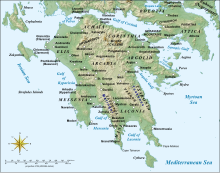Barony of Arcadia
| Barony of Arcadia | |||||||||
|---|---|---|---|---|---|---|---|---|---|
| Barony of the Principality of Achaea | |||||||||
| c. 1261–1432 | |||||||||
 Map of the Peloponnese with its principal locations during the late Middle Ages | |||||||||
| Capital | Arcadia (Kyparissia) | ||||||||
| Area | |||||||||
| • Coordinates | 37°14′N 21°40′E / 37.233°N 21.667°E | ||||||||
| • Type | Feudal lordship | ||||||||
| Historical era | Byzantine reconquest | 1432 | |||||||
| |||||||||
The Barony of Arcadia was a medieval Frankish fiefdom of the Principality of Achaea, located on the western coast of the Peloponnese peninsula in Greece, and centred on the town of Arcadia (Greek: Ὰρκαδία; French: l'Arcadie; Italian: Arc[h]adia), ancient and modern Kyparissia.[1]
History
The Barony of Arcadia was not one of the original twelve secular baronies of the Principality. Initially, Arcadia—the medieval name of
After Vilain's death in 1269 it was divided between his sons, Erard and Geoffrey. Erard disappears after 1279, when he was captured by the Byzantines, but Geoffrey did not manage to reclaim his brother's portion until 1293, due to the obstructions of the
Arcadia was the last holdout of the Principality. After the conquest of Patras and Chalandritsa by the Byzantines of the Despotate of the Morea in 1429–30, which signalled the de facto end of the Principality, the last Prince, Centurione II Zaccaria, retained Arcadia as his personal fief, but after his death in 1432, his son-in-law, Despot Thomas Palaiologos, annexed it and imprisoned Centurione's widow, who died in prison.[11][12]
Barons
- Vilain I of Aulnay, 1262–1269
- Erard I of Aulnay, 1269–1279, and his brother
- Geoffrey of Aulnay, 1269–1297
- Vilain II of Aulnay, 1297–unknown
- Erard II of Aulnay, unknown–before 1338 (1324?), and his sister
- Agnes of Aulnay with her husband Stephen Le Maure (married 1324), unknown–after 1330
- Balzana Gozzadini, widow of Erard II, with Peter dalle Carceri, ca. 1338 (1324?)
- Erard III Le Maure, after 1330–1388
- Andronikos Asanes Zaccaria, 1388–1401
- Erard IV Zaccaria, 1401
- Centurione II Zaccaria, 1401–1432
References
- ^ Bon 1969, pp. 412–413.
- ^ Bon 1969, pp. 104, 128, 412–413.
- ^ a b Topping 1975a, p. 120.
- ^ Bon 1969, pp. 157, 413.
- ^ Bon 1969, pp. 236, 413.
- ^ Bon 1969, pp. 205, 236, 413.
- ^ Bon 1969, pp. 236–237, 413, 418.
- ^ Bon 1969, p. 239.
- ^ Topping 1975a, pp. 132–133.
- ^ Bon 1969, pp. 276, 278, 413–414.
- ^ Bon 1969, pp. 292–293, 413.
- ^ Topping 1975b, p. 165.
Sources
- Bon, Antoine (1969). La Morée franque. Recherches historiques, topographiques et archéologiques sur la principauté d'Achaïe [The Frankish Morea. Historical, Topographic and Archaeological Studies on the Principality of Achaea] (in French). Paris: De Boccard. OCLC 869621129.
- Topping, Peter (1975). "The Morea, 1311–1364". In ISBN 0-299-06670-3.
- Topping, Peter (1975). "The Morea, 1364–1460". In ISBN 0-299-06670-3.





